Switzerland

Switzerland is about white Alpine summits, old cities, stunning waterfalls, and lakes. It is also about ordered life away from any turmoil and about cosy cafes with the ravishing smell of coffee and chocolate. Those things have long been synonymous with wealth, stability, and respectability.
Swiss watches became the benchmark of accuracy long ago. Swiss banks are considered the most reliable places to keep big money in: never in their history have they been robbed.
The people of Switzerland are rich and happy, and they have not known what the war is for more than three hundred years. A bright red Swiss passport with a white cross is the most desired document for people who dream about obtaining new citizenship.

General Information
Switzerland is a small Alpine confederation. Though it does not have marine borders, this does not deter it from maintaining a well-developed merchant shipping, which is the largest among those of the entirely landlocked countries. Most of the Swiss territory is covered by the Alps and the Jura Mountains. The rest consists of plateaus.
History
Switzerland emerged on the map of the world due to the Helvetians (Celtic tribes) and Romans who later conquered those lands. The Roman rule contributed to the foundation of the first cities that still exist - Geneva, Lausanne, Zurich, and Basel. Now their history extends over several millennia.
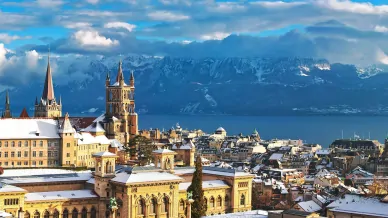
Lausanne, Switzerland
Then there were shifts of power. Romans were replaced by the Burgundians, who were changed by the Alemanni and the Franks. In the Middle Ages, Switzerland used to be a territory divided into several weak kingdoms inherited by the sons of Emperor Charles the Great.
In the 11th century, the Old Swiss Confederacy was established as a union of independent cities that was steadily expanding and becoming stronger and stronger. Victories in several wars against Holy Roman Empire lead to the independence of the union de facto. Moreover, they also laid the basis for the policy of neutrality that Switzerland adheres to until now.
This neutral status was officially entrenched in 1815.
Then the Reformation took place and was later followed by religious and civil wars. Switzerland split into Catholic and Protestant parts. The western cantons of the country sympathised with Protestants most. Those territories were the refuge for the Huguenot dynasties persecuted by the Catholics.
There were many jewelers, watchmakers, and bankers among the migrants. So that was the inception of the main direction of Swiss economic development. And this path is followed now as well.

Swiss watchmaker
A couple of centuries were needed to experiment with the abolishment of the federal-state system and establishment of a republic, returning the status of confederation, and formation of all branches of power.
In 1848, the Constitution was adopted along with establishing the two-chamber Federal Assembly, Federal Council, and Federal Supreme Court. The name ‘Swiss Confederation’ has been retained up to date since 1850.
At that time, the Swiss franc as the national currency emerged. And it has remained the official means of payment of Switzerland and Liechtenstein.
There are four official languages in the Confederation: French, German, and Italian bear the federal status and are mandatory to be used across the entire country. The Romansh language is spoken by the residents of Graubünden, the canton with a population of 39,000 people. The language is official but of regional status.
The Swiss Confederation consists of 26 cantons with a population of 8.5 million people, 25% of whom are migrants from all over the world.
Switzerland still does not have one capital, though de facto the functions are performed by Bern - the capital of the central canton. The population of Bern is 140,000 people, the majority of whom constitute the German-speaking Swiss and migrants from Germany and Italy. The other big cities are Zurich, Lausanne, Aargau, and Geneva.
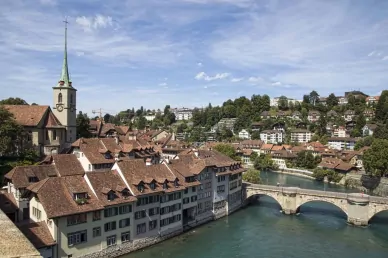
Bern, Switzerland
Climate
Location in mountains has had an impact on the Swiss climate. Winters in Switzerland are frosty and snowy, summers are mildly warm. Those are the features of continental climate typical for the entire centre of Europe.
Directions
Switzerland borders Italy to the south, Germany to the north, Austria and Liechtenstein to the east, and France to the west where Lake Geneva separates two countries.
So it is easier to get to Switzerland from Germany, Italy, France, and Austria. There are high-speed trains as well as convenient bus and flight connections.

Accommodation
When choosing a vacation site in Switzerland, not only the aim but the travel budget is important as nowhere else in Europe.
Wealthy tourists opt for Zurich, Geneva, some expensive resorts like Zermatt or St. Moritz.
Those willing to go on a budget trip tend to choose border cities like Basel (near the border with Germany and France), or Lugano (a cosy town close to the Italian border).
If to compare the prices for hotel rooms in Zurich or Bern and Basel, the same quality room will cost €100 and €30-€40 per night respectively.
The same comparison can be made in terms of food. The minimum bill in the restaurant of a big city will be €30 (without alcohol) while in Lugano a lunch will cost twice cheaper. Snacks will cost even cheaper - €5.
Lucerne is a happy medium. Prices here are not so high, and it will take an hour to get to Zurich from the city.
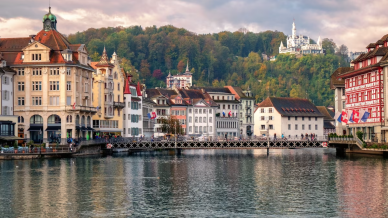
Old town in Lucerne, Switzerland
Below are several options of hotel rooms in Switzerland:
- Waldhotel Unspunnen is a two-star hotel in Interlaken with cosy and clean rooms, free parking and Wi-Fi.
- Primestay Schweiz AG is a low-budget hotel not far from Zurich. There are bright rooms with separate bathrooms and free Wi-Fi.
- Green Marmot Capsule Hotel Zürich, located not far from the Limmat river, offers the minimum facilities and shared bathrooms. The service is very good.
- Restaurant & Hostel Rendez-vous is conveniently located near the Oeschinensee gondola lift. The restaurant and service are of a high level.
- Jugendherberge Lugano is a youth hostel in Lugano with separate and shared rooms, a swimming pool, and a kitchen. Breakfast charge is included in the price. Free Wi-Fi.
The room price of all the above-mentioned hotels is not higher than €60.
One more accommodation option in Switzerland is renting a room offered by Swiss families. Apart from a room, owners of apartments and houses also offer cheap dinners and guided tours.
Lately, the Serviced Apartments has gained much popularity. Though the apartments offered for a short term are not very spacious (around 40m²) by Swiss standards, the rent will be much cheaper than a hotel room.
Places to See
The nature, mountains, and architecture of Switzerland will dazzle everyone coming here for the first time. Even those who visit this blessed place frequently find something new for themselves every time.
If to imagine that you have only one week to take great delight in acquaintance with Switzerland, below are five places, without which this trip will lose its charm at least by half:
The Rhine Falls
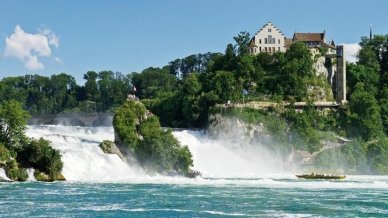
Rhine Falls – Europe’s Biggest Waterfall
The 20-metre waterfall is the most powerful and spectacular within the whole European continent.
It was formed around 15,000 years ago in the north of Switzerland, not far from Zurich.
Magnificent views open at comfortable viewing decks. It becomes visible how the flows of water of ancient and mighty Rhine cascade between the woodlands. There are two more attractions near the waterfall: the old castles of Laufen and Wörth that have retained the spirit of the Middle Ages and knighthood romance.
Lake Geneva
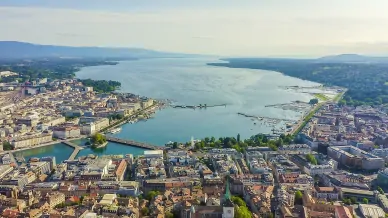
Lake Geneva
This largest lake in Europe can be even called the sea. Local navigation includes tourist boats, motorboats, and ships. A particular interest is evoked by belle epoque style ships. These paddled steamers have been renovated and put afloat for guided tours.
The programme includes ordinary and gastronomical cruises and seeing the sights of Geneva from aboard.
Chillon Castle
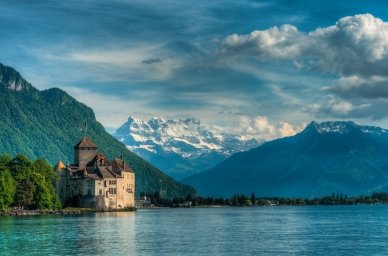
Château de Chillon (Chillon Castle), Montreux, Switzerland
A guided tour of Lake Geneva is impossible without visiting an ancient 9th-century castle. It used to be a residence of princes and a fortress that protected Via Francigena - the street of pilgrims journeying from Italy to England and France.
Chillon Castle is accessible by water from Lake Geneva. Its completely restored halls keep numerous items of furniture and utensils of the Middle Ages era.
Ballenberg
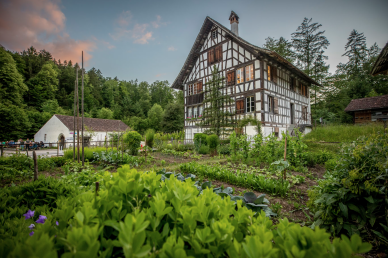
Ballenberg, Swiss Open-Air Museum
If you want to visit a true Swiss village where the time stopped 50 years ago, Ballenberg is exactly the one to opt for. It is an open-air museum of rural life created by the caring Swiss who did not dare to demolish their old houses in order to build new ones. These people have managed to take them to pieces, to transfer, and then to put everything together to keep the charm of rural ancientry.
Initially, there were 16 houses, but the idea of transferring was supported by the entire country. So with the course of time, a village in Ballenberg has changed into the museum complex. At present, there are more than a hundred houses brought from all cantons.
Zurich’s Old Town
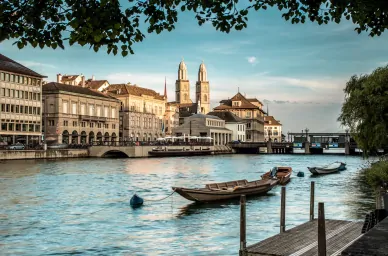
Zurich’s Old Town
The streets of the old town were built in the 9th - 10th centuries. The Middle Ages houses with peaked roofs stand close to each other and have flowerpots on windowsills instead of window curtains. This is Zurich, one of the oldest and most beautiful cities in Europe.
Start your tour of Zurich with its squares - Paradeplatz and Bürkliplatz. The first one is particularly beautiful during Christmas time when holiday fairs offer loads of souvenirs and sweet treats. The latter is famous among the European party persons for the most spectacular concerts held there.
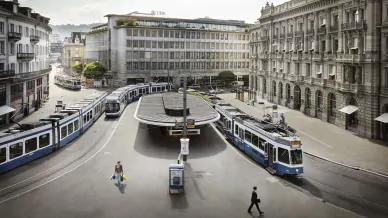
Paradeplatz, Zurich
St. Peter Church is one of the brightest city attractions. It is well-known for its clock face on the tower - the largest in Europe. Those who like religious monuments should go to Fraumünster, which is currently a Catholic church, and Grossmünster, a male monastery church.
A Zurich’s must-see places list also includes Bahnhofstrasse (the world’s most expensive shopping avenue) and Langstrasse. The latter one is a spicy element added to the portrait of a respectable city. It is an analogue of the famous De Vallen - Amsterdam’s Red Light District.
Food
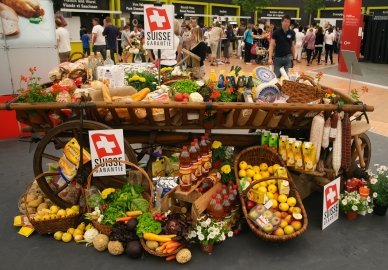
Swiss food products
Swiss cuisine is a bright mixture of cooking traditions of the five neighbouring countries. Italy has brought polenta and risotto - typical Lombardy dishes. Germany and Austria contributed with thick soups, sausages, and plain but tasty pastry.
France has presented its famous soups, exquisite meat, and fish dishes. However, the Swiss have their own world-famous recipes.
An absolute leader is cheese fondue invented in the canton of Vaud. They melt several cheese types, add garlic, herbs, and kirsch, and then roast this flavourous mix in special pots (caquelons).
It is an easy-to-eat thing: you just need to dip bread slices, vegetables, or potato pieces in a hot substance and eat it straight away. This dish is perfect for a group of people, and what is more, it is so esteemed by the Swiss that is served not only in its homeland - Lausanne but in any restaurant around the country.
The Grisons residents are savvy about meat delicacies. Beef jerky, as a snack for beer or some other spirits, is particularly tasty.
By Lake Geneva, there is a cafe where the local specialty - perch fillet - should be tried as a must. In the canton of Valais, try cholera pie - the pastry with a funny name invented by local housewives. They were so desperate during the times of cholera that had to find ways out to provide their families with cheap but filling meals. Though the cholera pandemic ended long ago, the recipe has remained. The pie consists of potatoes, apples, and cheese.
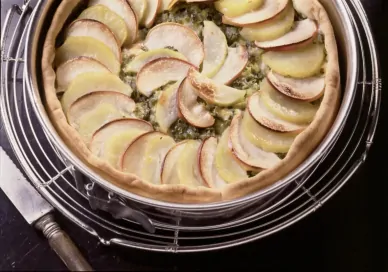
Cholera pie
Rööschti is a Swiss dish that consists of grated potatoes as the basis for all recipes. Each locality has its own variation. For example, in Basel, they add onions to the potato mass while in the other regions the recipes contain cheese, bacon, greenstuff, and even apples. Anyway, it is a serving of plain and filling crispy crust fritter that will be definitely enjoyed by the whole family.
The drinking traditions of Switzerland are directly connected to the traditions of neighbouring countries. The Swiss like beer as Germans do. A bottle of lager is an essential purchase every time they go to a supermarket. They also drink wine as a result of bordering Italy. The most popular local varieties are Fendant and premium red and rose wines.
The menus of Swiss restaurants include such hard liquors as kirsch and pear brandy.
Interestingly, there are no legal restrictions imposed on bringing out the booze from the country.
If you want, you may take even more than ten bottles at once when coming back from the journey.
Nonetheless, the main beverage of Switzerland has nothing to do with alcohol. It is hot chocolate, the national pride of the Alpine country. It will be difficult to cope with more than a small cup of this thick, flavourous, and a very sweet treat at one go. But what a yummy it is!
The Swiss regard chocolate as something truly special - with trembling and much respect. They never skimp on its recipes and technologies to get a tender melting-in-the-mouth treat. Around 5,000 people deal with chocolate manufacturing, which constitutes 0.5% of the total population.
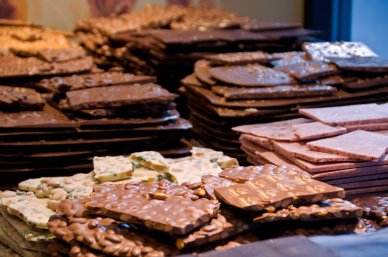
Läderach Chocolate
But even this small number of people manage to add 2 billion francs to the national budget.
Chocolate is eaten here by everyone and at every given opportunity. And the number of chocolate desserts is so vast that it can be neither calculated nor comprehended. In every city and town, there is a cafe or a confectionary, the flavours of which spread throughout the area. These places are always crowded.
A bar or a box of dark, milk or white chocolate will be the best souvenir brought from the country even for the most dedicated ascetic.
Switzerland is simply beautiful. It is the paragon of virtue, the dream, and the country that makes it clear that the world is not going to fall apart as long as there are Swiss banks, watches, and chocolate.
FAQ
What is the official language of Switzerland?
Switzerland has four official languages: German, French, Italian, and Romansh.
What is the population of Switzerland?
The population of Switzerland is approximately 8.5 million people.
Where is Switzerland capital?
Switzerland still does not have a single capital, although Bern, the capital of the central canton, de facto performs its functions.
What is the Swiss currency?
The currency of Switzerland is the Swiss Franc (CHF).
What is the territory of Switzerland?
Switzerland covers an area of approximately 41,290 square kilometers.
What is Switzerland famous for?
Switzerland is famous for its watches, chocolates, cheese, neutral political stance, banking system, and the Alps, among other things.
Why is Switzerland not in the EU?
Switzerland is not a member of the EU because it values its tradition of neutrality, independence, and direct democracy. The Swiss people have also rejected EU membership in referendums.
Is Switzerland a member of the Schengen area?
Yes, Switzerland is a member of the Schengen Area, even though it is not a member of the European Union. This means that Switzerland adheres to the Schengen Agreement, which allows for passport-free travel between member countries.
Why Switzerland is so expensive?
Switzerland is so expensive due to various factors, including high wages, a strong currency, a high standard of living, and the quality of goods and services provided.
Is it possible to use euros in Switzerland?
Yes, it is possible to use euros in many places in Switzerland, especially in tourist areas. However, the Swiss Franc is the preferred and most widely accepted currency.







